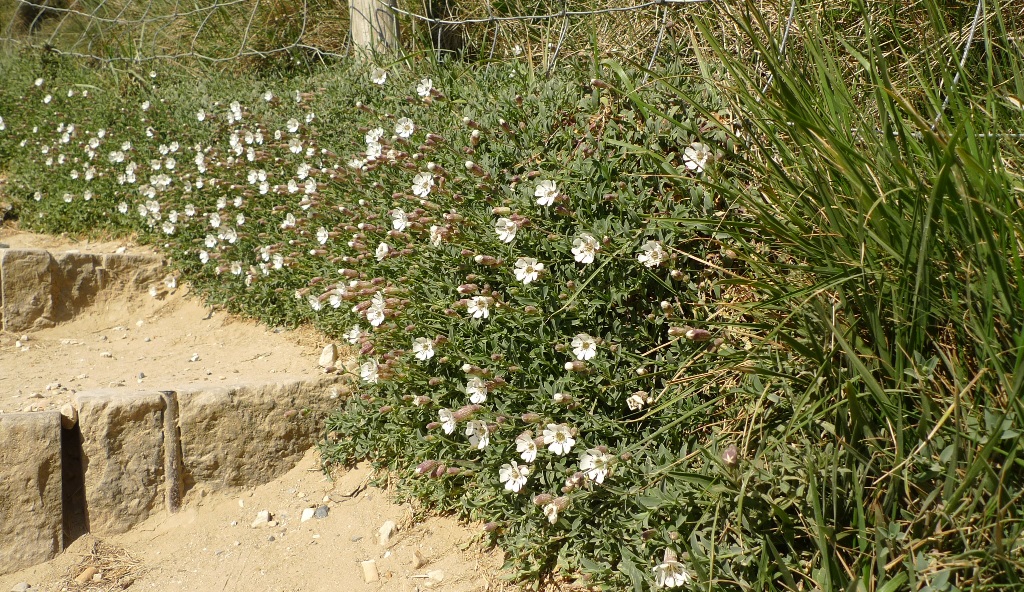
This is the second part of useful (with many ornamental) members of the Pink family or officially the Caryophyllaceae. The first part can be found here.
I am very fond of this family as well and have been growing several native and non native species from seed.
In part 2 there are four more members mentioned by Julian Barker in his Medicinal Flora, which have some medicinal use, which are Herniaria glabra or Smooth Rupturewort, Spergularia rubra or Sand Spurrey, Agrostemma githago or Corn-Cockle and Saponaria officinalis or Soapwort.
Click links for more info and pictures from various websites. Scientific/Latin Name usually has link from the Online Atlas of the British Isles and Irish Flora. Pink background means a warning use (= poisonous!) or medicinal use, green for other uses and blue for plant habitat, interesting facts or wildlife use.
If described in the Flora of Birmingham and the Black Country it will be highlighted by FBBC in the Content page.
In Part 1 we covered Subfamily Alsinoideae which has 11 genera. In Part 2 we will cover another 11 genera in 2 subfamilies:
- 2 Subfamily Paronychioideae with 5 genera (genera 12-17)
- 3 Subfamily Caryophylloideae with 6 genera (genera 18-24)
Contents:
Subfamily 2 PARONYCHIOIDEAE
12 Corrigiola litoralis or Strapwort
13 Herniaria spp.or Ruptureworts
- H. glabra or Smooth Rupturewort
- H. ciliolata or Fringed Rupturewort and 2 ssp. a) Ssp ciliolata & Ssp. subciliata
- H. hirsuta or Hairy Rupturewort
14 Illecebrum verticillatum or Coral-necklace
15 Polycarpon tetraphyllum or Four-leaved Allseed
16 Spergula spp. or Spurreys
- S. arvensis or Corn Spurrey with also 3 different varieties. FBBC
- S. morisonnii or Pearlwort Spurrey
17 Spergularia ssp. or Sea-spurreys
- S. rupicola or Rock Sea-spurrey
- S. media or Greater Sea-spurrey
- S. marina or Lesser Sea-spurrey FBBC
- S. rubra or Sand Spurrey FBBC
- S. bocconei or Greek Sea-spurrey
Subfamily 3 CARYOPHYLLOIDEAE
18 Agrostemma githago or Corncockle FBBC
19 Silene spp. or Campions
- S. italica or Italian Catchfly
- S. nutans or Nottingham Catchfly
- S. catholica or Worcestershire Catchfly
- S. otitis or Spanish Catchfly
- S. vulgaris or Bladder Campion with 2 ssp. : Ssp. vulgaris and Ssp. macrocarpa FBBC
- S. uniflora or Sea Campion FBBC
- S. macrophylla or Fringed Catchfly
- S. acaulis or Moss Campion
- S. schafta or Caucasian Campion
- S. alpestris or Alpine Catchfly
- S. armeria or Sweet-William Catchfly FBBC
- S. noctiflora or Night-flowering Catchfly
- S. latifolia or White-Campion FBBC
- S. dioica or Red Campion FBBC
- S. x hampeana (Silene dioica × latifolia) or Hybrid Campion FBBC
- S. coeli-rosa or Rose-of-heaven
- S. pendula or Nodding Catchfly
- S. gallica or Small-flowered Catchfly FBBC
- S. conica or Sand Catchfly FBBC
- S. coronaria or Rose Campion FBBC
- S. flos-cuculi or Ragged -Robin FBBC
- S. chalcedonica or Maltese-Cross
- S. viscaria or Sticky Catchfly
- S. suecica or Alpine Catchfly
- S. baccifera or Berry Catchfly
- S. muscipula or Mousetrap catchfly
- S. dichotoma or Forked Catchfly
20 Saponaria officinalis or Soapwort FBBC
21 Vaccaria hispanica or Cowherb FBBC
22 Petrorhagia spp. or Pinks
- P. nanteuilii or Childing Pink
- P. prolifera or Proliferous Pink
- P. dubia or Hayling Island Pink
- P. saxifraga or Tunicflower
23 Gypsophila paniculata or Baby’s-breath FBBC
G. elegans or Annual Baby’s-breath
24 Dianthus spp or Pinks
- D. gratianopolitanus or Cheddar Pink
- D. caryophyllus or Clove Pink FBBC
- D. plumarius or Pink FBBC
- D. gallicus or Jersey Pink
- D. deltoides or Maiden Pink FBBC
- D. barbatus or Sweet-William FBBC
- D. armeria or Deptford Pink FBBC
Subfamily 2 PARONYCHIOIDEAE
12 Corrigiola litoralis or Strapwort
An annual herb of periodically inundated, open, muddy shingle around the margins of Slapton Ley (South Devon). It formerly grew in a similar site at Loe Pool (West Cornwall), where it has recently been reintroduced, and casual plants have been recorded elsewhere, from railway ballast and waste ground.
13 Herniaria spp. or Ruptureworts
- H. glabra or Smooth Rupturewort
- H. ciliolata or Fringed Rupturewort and 2 ssp. a) Ssp ciliolata & Ssp. subciliata
- H. hirsuta or Hairy Rupturewort (Neophyte)
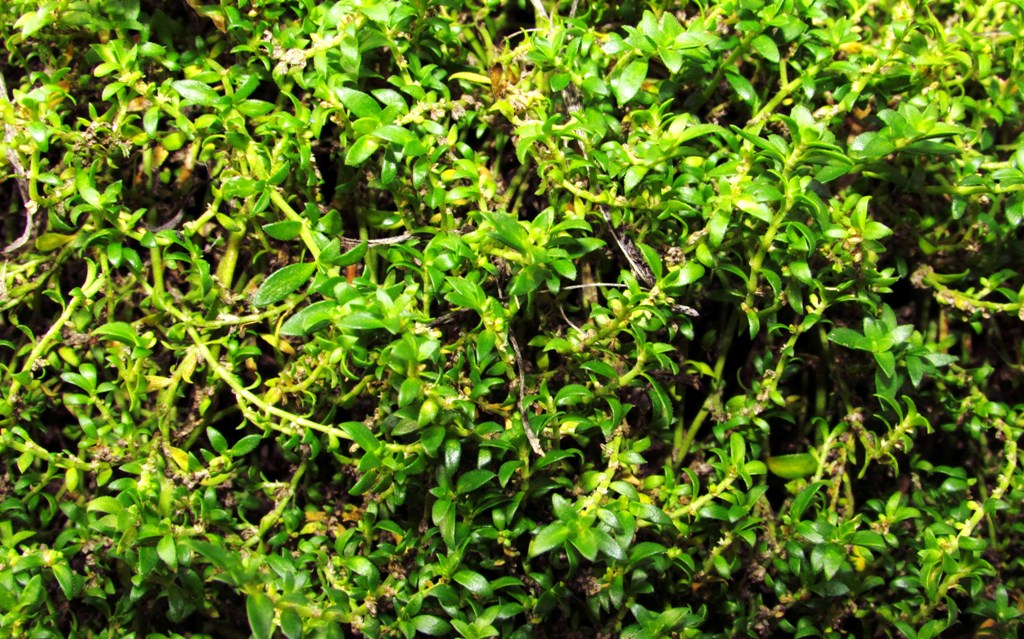
Herniaria glabra or Smooth Rupturewort
An annual or short-lived perennial of compacted sandy or gravelly soils, often with chalk or limestone fragments. Its habitats are generally kept open by seasonal standing water or other disturbance, and include forestry rides, golf courses, car parks, disused gravel-pits and disturbed areas in short grassland.
Herniaria is an attractive foliage plant which I was given by a good friend of Ecorecord. I’ve just read that it makes a good alternative to replacing grass as an evergreen ground cover!
Grows well in hot dry soils[1]. Dislikes excessive moisture[1]. Succeeds in very poor soils[1]. Useful for covering rocks or as a carpet bedding[1], it makes a good ground cover for spring bulbs since they can grow through it easily[200]. The leaves emit a musky smell when they are handled
The name Herniaria is derived from the coumarin called herniarin which it contains and which is also found in Lavandula latifolia as well as in some members of the Asteraceae. The known action of this plant is on the bladder and kidneys where it helps remove salt and urea. It sooths urinary tract pain.
14 Illecebrum verticillatum or Coral-necklace
An annual herb of seasonally wet acidic to neutral soils, found on periodically disturbed gravelly tracks, pool and ditch margins, in very short heathlands and grasslands and in the sandy drawdown zone of a loch; it is also recorded as an introduction around docks, mills and on clinker along railway sidings.
15 Polycarpon tetraphyllum or Four-leaved Allseed
A summer- or occasionally winter-annual herb found in open, sunny coastal sites that are droughted in summer and relatively frost-free in winter, where it grows with other therophytes on steep south-facing banks, on compacted shingle or sand, and in bulb-fields. Increasingly, it is also found inland in gardens, caravan parks, gravel driveways, at the base of walls and as a pavement weed.
16 Spergula spp. or Spurreys
- S. arvensis or Corn Spurrey with also 3 different varieties.
An annual herb, possibly only native on granite cliff ledges in the Channel Islands where it occurs as a genetically dwarfed variety (var. nana). Elsewhere it is an archaeophyte found in open, disturbed habitats on light, often sandy soils, most frequently in arable fields but also on sea-shores, roadsides and waste ground. It tends to avoid calcareous soils.
- S. morisonnii or Pearlwort Spurrey (a neophyte)
17 Spergularia ssp. or Sea-spurreys
- S. rupicola or Rock Sea-spurrey
- S. media or Greater Sea-spurrey
- S. marina or Lesser Sea-spurrey
- S. bocconei or Greek Sea-spurrey (Neophyte)
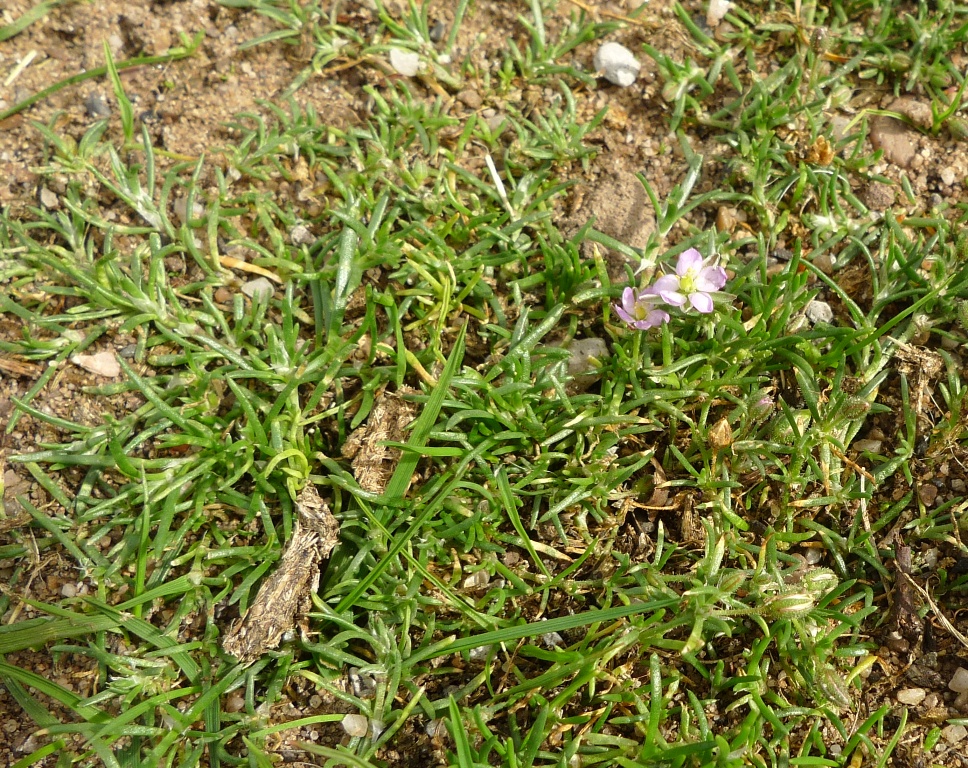
Spergularia rubra or Red Sand Spurrey
An annual or biennial herb, typically occurring in open habitats on free-draining acidic sands and gravels. Habitats include heaths, commons, tracks (particularly forestry tracks in W. Scotland), quarries, gravel- and sand-pits, railway yards and waste ground. It occasionally grows on stabilised shingle and sand dunes. It is tolerant of trampling.
Spergularia rubra or Red Sand Spurrey, is a pretty sprawling plant which according to Decaux is an effective remedy against the pain of kidney and bladder infections and deserves to recover its former popularity. See also here.
Subfamily 3 CARYOPHYLLOIDEAE
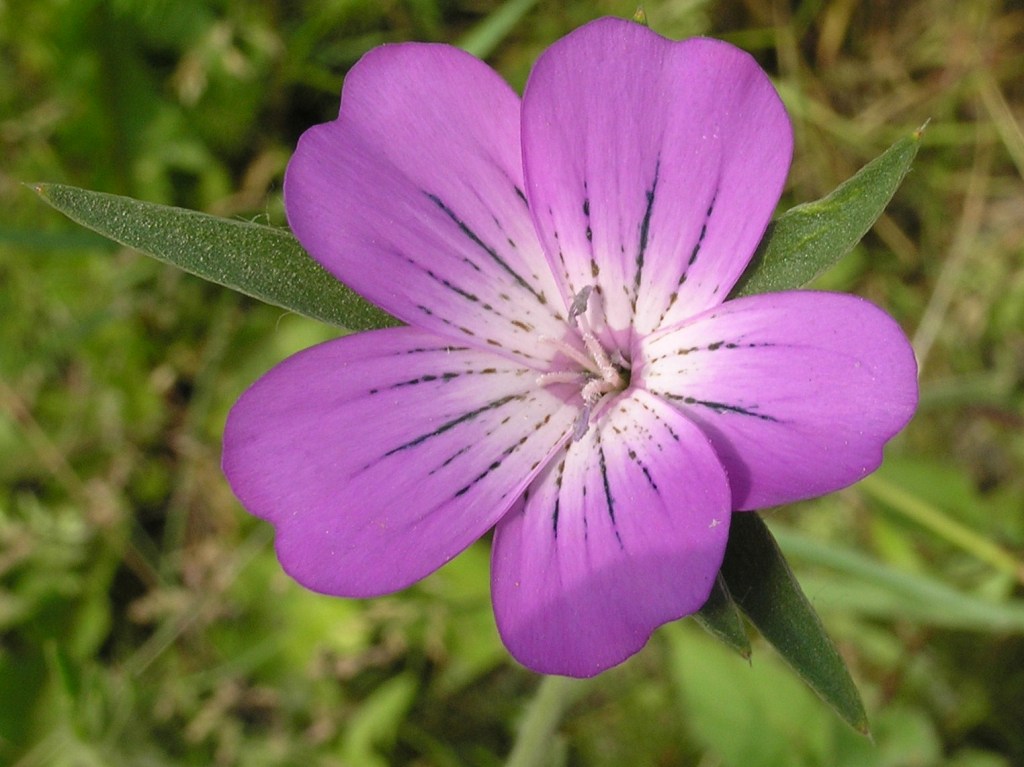
18 Agrostemma githago or Corn-Cockle
An annual weed of cereal and other arable crops, tolerant of various soil types, with its past distribution largely mirroring that of the crops in which it grew. Now largely restricted to urban areas and road sides where it is deliberately sown in seed mixtures.
A. githago, was accidentally introduced as a grain contaminant and has been present in Britain since the Iron Age. Although common until the 20th century, it has dramatically declined with improved seed cleaning. It is now extinct as an arable weed, but is a frequent component of wild-flower seed mixtures.
It was probably native to the Mediterranean but became a troublesome agricultural weed in the UK a long time ago. It is probably the only member of the family which is poisonous to animals and there is some history of human poisoning which has come about by long term eating of bread made from flour contaminated by ground Corn-Cockle seeds. It is one of the oldest weeds of cereals and is probably, along with Darnel (p.487 in Medicinal Flora), one of the weeds in the Parable of the Sower (Matthew 13). The leaves have been used medicinally and even as food in time of famine.
Toxicity:
All parts of the plants are poisonous and contain githagin and agrostemmic acid. It has been used in folk medicine despite the risk of fatal poisoning.
The plant was believed to be completely extinct in the United Kingdom until 2014, when a single specimen was found growing in Sunderland by an assistant ranger of the National Trust.
It is now often sown as part of an attractive cornfield mix flower.
19 Silene spp. or Campions and Catchflies
Most of the Campions or Silene are common in their native habitats only. I learnt through Wikipedia that the genus Silene has 700 species worldwide and is therefore the largest genus of the family.
- S. italica or Italian Catchfly (neophyte)
S. nutans or Nottingham catchfly (neophyte in Ireland))
- S. catholica or Worcestershire Catchfly (neophyte)
- S. otitis or Spanish Catchfly

S. vulgaris or Bladder Campion with 2 ssp. : Ssp. vulgaris and Ssp. macrocarpa
S. vulgaris is a perennial herb found in a wide range of soils in open and grassy habitats, including cultivated and abandoned arable fields, rough pasture, roadside verges, quarries, gravel-pits, railway banks, walls and waste places. The Bladder Campion (S. vulgaris) as well as the similar lower growing Sea Campion or (S. uniflora) are a lot of fun as they both keep their ‘bladders’ long after the white flowers have faded. These are really an adapted calyx-tube.
- Young shoots and leaves – raw or cooked.
- The young leaves are sweet and very agreeable in salads.
- The cooked young shoots, harvested when about 5cm long, have a flavour similar to green peas but with a slight bitterness. This bitterness can be reduced by blanching the shoots as they appear from the ground.
- When pureed it is said to rival the best spinach purees.
- The leaves can also be finely chopped and added to salads. The leaves should be used before the plant starts to flower.
Some caution is advised: Although no mention of toxicity has been seen for this species, it does contain saponins. Although toxic, these substances are very poorly absorbed by the body and so tend to pass through without causing harm. They are also broken down by thorough cooking. Saponins are found in many plants, including several that are often used for food, such as certain beans. It is advisable not to eat large quantities of food that contain saponins. Saponins are much more toxic to some creatures, such as fish, and hunting tribes have traditionally put large quantities of them in streams, lakes etc in order to stupefy or kill the fish[K]. The Catchflies such as Sticky Catchfly (S. viscaria), Night-flowering Catchfly (S. noctiflora),Nottingham Catchfly (S. nutans) and others are a lot more rare.

Silene uniflora or Sea Campion (by Matt Summers)
S. uniflora or Sea Campion
A perennial herb of rocky sea-cliffs from the lowest zone of vascular plants to cliff-top grassland, on sea-walls, shingle banks and on drift-lines. It can tolerate high levels of nutrient enrichment, and can be abundant on cliff-tops adjoining seabird colonies. It also occurs rarely on upland lake shores, streamsides, river shingle, cliffs and in gullies. Artificial habitats include metalliferous mine spoil, disused railway lines, ballast and refuse tips.
- S. macrophylla or Fringed Catchfly (neophyte)
- S. acaulis or Moss Campion
- S. schafta or Caucasian Campion (neophyte)
- S. alpestris or Alpine Catchfly (neophyte)
- S. noctiflora or Night-flowering Catchfly (archaeophyte)
- S. muscipula or Mousetrap Catchfly (neophyte?)
- S. dichotoma or Forked Catchfly (neophyte)
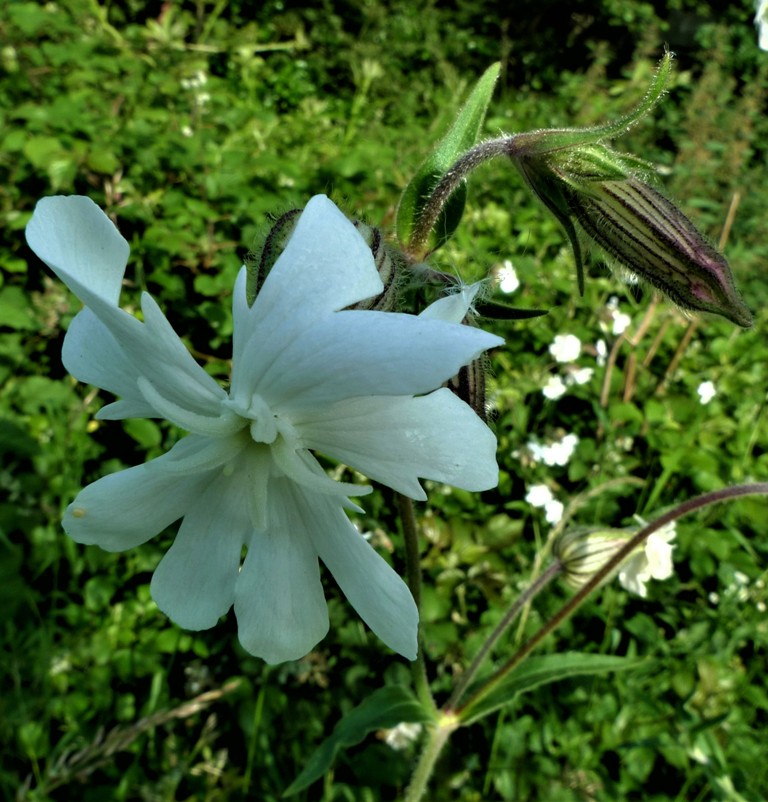
S. latifolia or White-Campion
Usually a short-lived, winter-green perennial, but reportedly sometimes annual or biennial, found on the sides of roads, tracks and paths, arable land, in hedgebanks and waste places, being most abundant on deep, well-drained soils. Recently suspected of being widely sown in wild-flower seed mixtures.
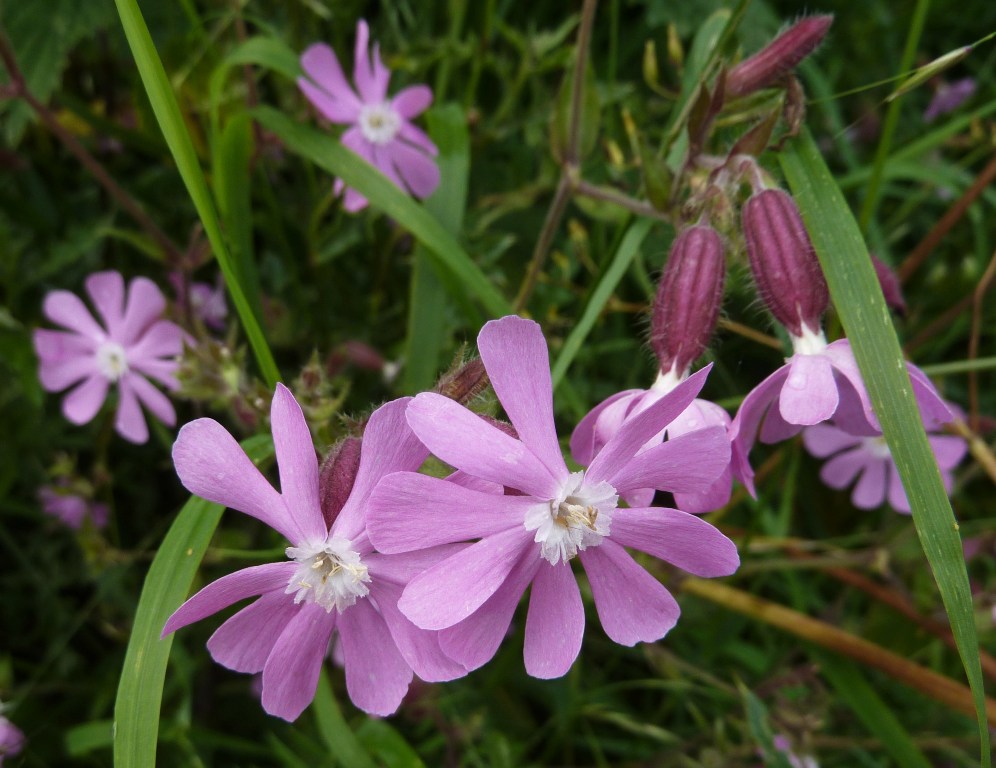
S. dioica or Red Campion
A short-lived perennial herb that is most prominent in lightly shaded habitats such as hedgerows, coppices, and woodland clearings and rides. It can, however, survive in deep shade in a non-flowering form.
This is probably the most common Campion here in the Midlands, a colourful plant in hedgerows and anywhere in moisture retentive soil. Good for the wildlife garden, together with bluebells and cow-parsley in dappled shade.
One particularly notable garden variety is a hot pink, double flowered variety with deep green leaves called ‘Firefly’. It could easily be called a nativar of which you can read more in an earlier post!
Besides the aesthetic value of its flowers, the crushed seeds of red campion have also been used to treat snakebites!
The nectar of the flowers is utilised by bumblebees and butterflies, and several species of moth feed on the foliage.
- Red Campion leaves are an ingredient of pistic, a traditional spring dish eaten in northern Italy.
- Red Campion wine was made in 20th-century Britain by boiling oranges, lemons, red campion flowers and leaves with barley and sugar.
- The young shoots can be blanched to reduce their bitterness and made into a puree similar to spinach.
- The leaves of the plant can be added to a variety of dishes, including salads, soups, stews, sauces, herbal cheeses and even as a substitute for asparagus.
Campions (of any species) were once used to treat internal bleeding, kidney disease, sores and ulcers, and stings. Healers also used it to treat warts and corns. In parts of Spain and Italy, the plant was sometimes used for digestive disorders.
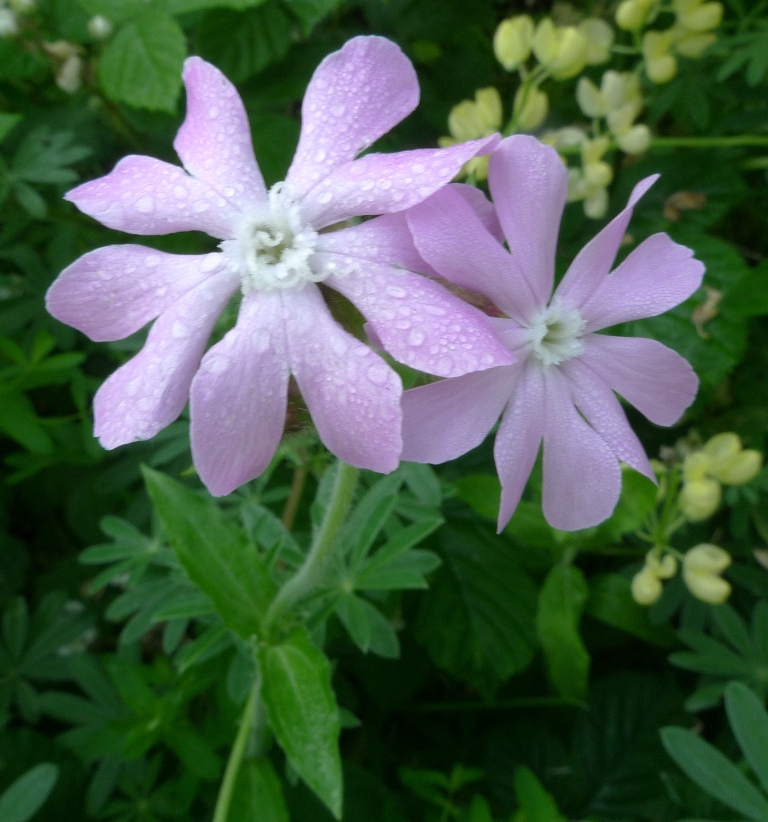
S. x hampeana (Silene dioica × latifolia) or Hybrid Campion
This perennial hybrid is not uncommon and is found predominantly on woodland margins and rides, on scrubby banks and in hedgerows and field edges. In many sites it is present as isolated individuals, sometimes in the absence of S. dioica, but it is usually encountered with both parents present and shows quite high levels of fertility, and back-crossing to the parents may give rise to hybrid swarms.
- S. coeli-rosa or Rose-of-heaven (neophyte)
- S. pendula or Nodding Catchfly
- S. gallica or Small-flowered Catchfly (archaeophyte)
- S. conica or Sand Catchfly
- S. coronaria or Rose Campion (neophyte)
Attractive garden plant! This plant is still often known as Lychnis coronaria.
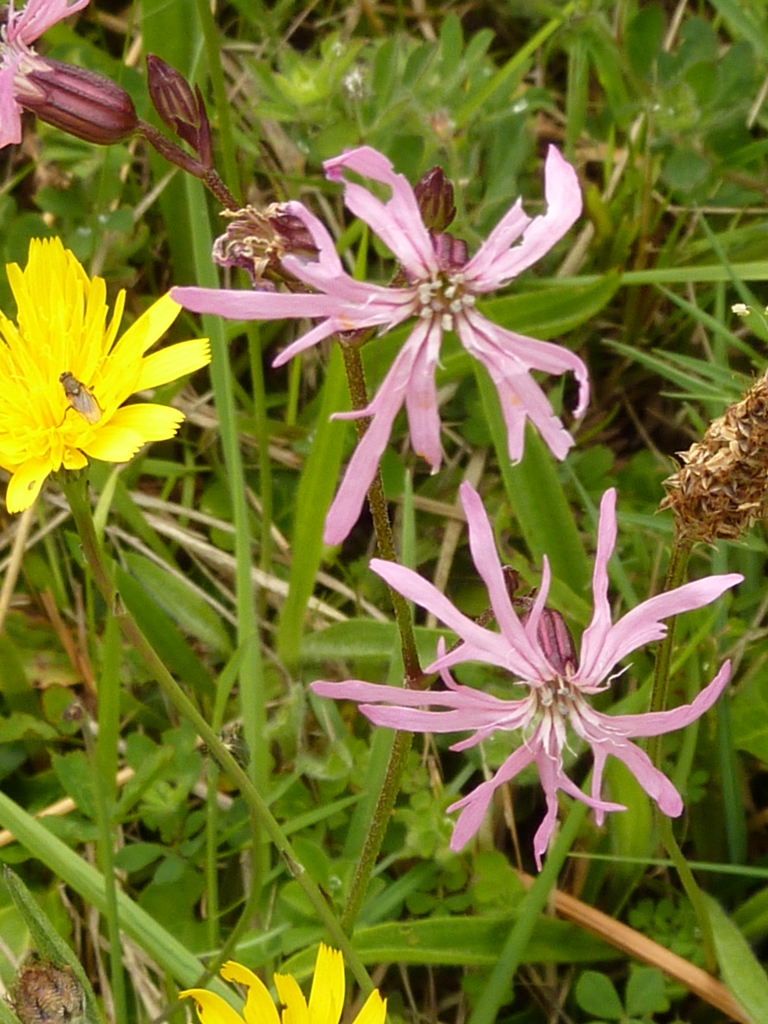
S. flos-cuculi or Ragged-Robin
S. flos-cuculi is a herb of damp habitats, found in wet grassland, rush-pasture, fen-meadow, ditches, tall-herb fen and damp woodland margins. A dwarf form (var. congesta), known from exposed coastal grassland in E. Kent, Caithness, Sutherland and Shetland, apparently retains this character in cultivation. The following entertaining information, is from a very useful little book called ‘Weeds and what they tell us’ by Ehrenfried Pfeiffer, third print (2012) in association with the Biodynamic Farming & Gardening Ass. It is however a booklet for the New World and has therefore different weeds or the same but with different common names. “The Cuckoo flower (other name for the Ragged Robin) has evidently derived its name, cuckoo flower, from the fact that it blossoms when the cuckoo calls, or, perhaps, because of the legend of ‘cuckoo saliva’ or ‘spittle’ from the Old World. Ragged Robins bloom from May to August, occasionally later, and butterflies and long-tongued bees feed on the flowers nectar. Nevertheless, the flowers are visited by many types of insects, and can be characterized by a generalized pollination syndrome.
It can be a good garden plant in the right soil and even has several cultivars.
- S. chalcedonica or Maltese-Cross (neophyte)
An erect herbaceous perennial herb, found as a casual or, rarely, a naturalized garden escape on waste ground, roadsides and refuse tips.
It is a popular ornamental plant in gardens and has gained the Royal Horticultural Society’s Award of Garden Merit.
S. viscaria or Sticky Catchfly
A tufted evergreen perennial herb of rock outcrops and steep dry slopes with a predominantly southerly aspect. It prefers mildly acidic to moderately basic soils and many stations are on the more basic volcanic rocks such as basalt and dolerite, although a few are on metamorphic and sedimentary rocks.
S. viscaria is grown as an ornamental garden plant. In British horticultural literature it is often referred to by its synonym Lychnis viscaria. The cultivar ‘Splendens Plena’, a double-flowered form, has won the Royal Horticultural Society’s Award of Garden Merit.
This plant is said to increase the disease resistance of surrounding plants. Extract from S. viscaria contains a relatively high amount of brassinosteroids, which have a proven positive effect on the growth of other plants.
- S. suecica or Alpine Catchfly
- S. baccifera or Berry Catchfly (neophyte)
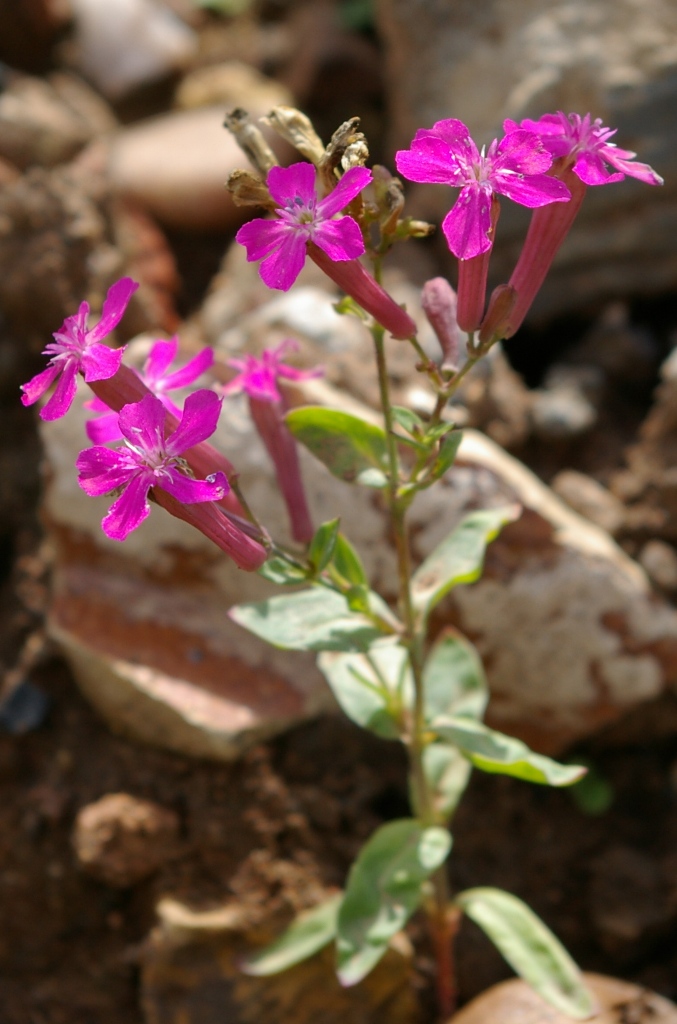
S. armeria or Sweet-William Catchfly
An annual herb, widely grown in gardens and found as escape or throw-out on refuse tips and waste places. It is usually casual, but may persist for a few years in disturbed, open sites, reproducing by seed.
It is a neophyte species which has been cultivated in Britain since before 1800. It was recorded from the wild by 1840, and its overall distribution is stable.
S. nutans or Nottingham catchfly
A long-lived perennial herb of shallow, drought-prone, calcareous soils on chalk and limestone, as well as acidic soil overlying shingle. Its coastal habitats include grassy coastal slopes and cliffs, sea-walls, sand dunes and shingle. Inland, it grows on limestone rock outcrops and cliff ledges, and more rarely on road verges and cultivated arable margins. It has occurred as a casual at ports and on railway banks. Reproduction is usually by seed, but can be vegetative by procumbent stems rooting at the nodes
The common name Nottingham catchfly commemorates the former occurrence of S. nutans on the walls of Nottingham Castle, and the species was chosen to represent the unitary authority of Nottingham as its county flower. Despite this association, Nottingham catchflies no longer occur in either the city of Nottingham or the wider county of Nottinghamshire.
20 Saponaria ocymoides or Rock Soapwort (neophyte)
A small perennial herb with decumbent or procumbent stems, widely grown in rock-gardens and found on walls, in churchyards, on refuse tips and on beaches, usually as a casual but sometimes naturalized.
Saponaria ocymoides is cultivated as an ornamental plant for rock gardens and dry stone walls, in well-drained alkaline or neutral soil in full sun. Like most alpine plants it dislikes winter wetness around its roots. It has gained the Royal Horticultural Society‘s Award of Garden Merit.
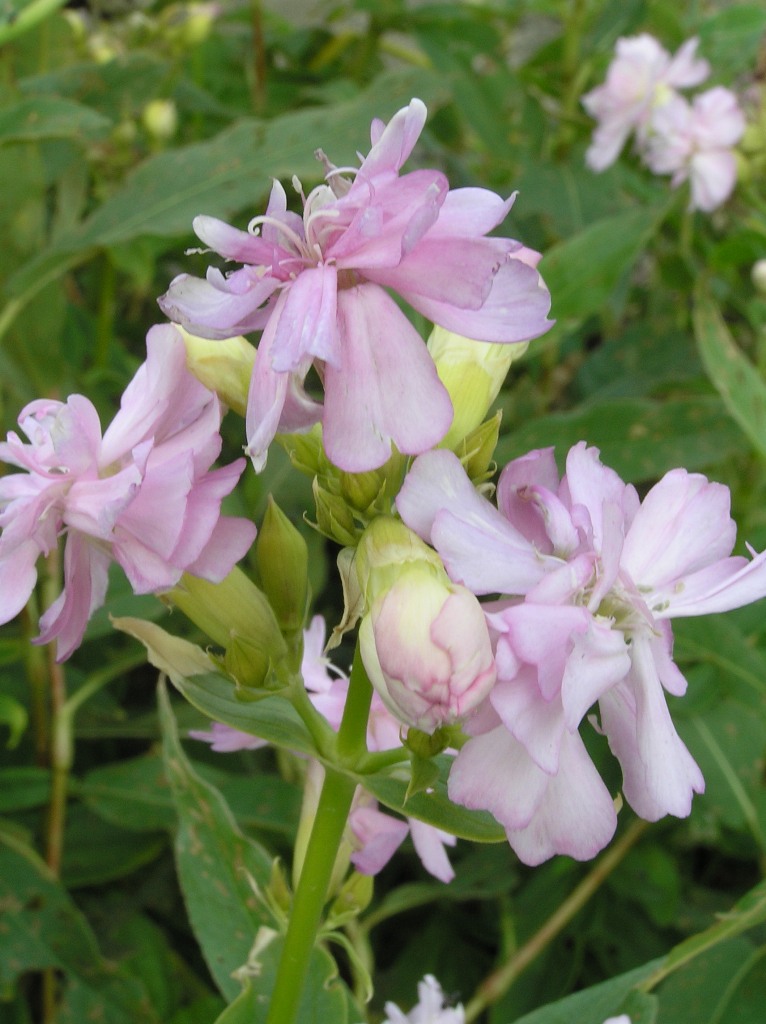
S. officinalis or Soapwort
This rhizomatous perennial herb is found in a wide range of man-made and marginal habitats, often near habitation, including hedge banks, quarries, roadsides, railway banks, tips and waste ground. Saponaria officinalis‘ native range extends throughout Europe, and in Asia to western Siberia. But it is probably an archaeophyte in the British Isles.
Soapwort was traditionally used as a cleansing agent for the hair and skin, and is still used in parts of the Middle East for gently washing woollens and tapestries.
It is an attractive perennial, although can be invasive!
The scientific name Saponaria is derived from the Latin sapo meaning “soap”, which, like its common name, refers to its utility in cleaning. The epithet officinalis indicates its medicinal functions.
From this same Latin word is derived the name of the toxic substance saponin, contained in the roots at levels up to 20 percent when the plant is flowering. According to PFAF this is much more toxic to some creatures, such as fish, and hunting tribes have traditionally put large quantities of them in streams, lakes etc in order to stupefy or kill the fish!
The individual flowers open in the evening and stay open for about three days.They produce a stronger scent at night and supplement nectar production during the hours of darkness. The flowers are visited by various insects including Noctuidae,Sphingidae, bumblebees, and hoverflies. I saw my first Hummingbird Moth on this flower at Rodbaston College, Staffordshire!
External use:
As its common name implies, it can be used as a very gentle soap, usually in dilute solution. It has historically been used to clean delicate or unique textiles; it has been hypothesized that the plant was used to treat the Shroud of Turin.
A lathery liquid that has the ability to dissolve fats or grease can be procured by boiling the leaves or roots in water. Take a large handful of leaves, bruise and chop them and boil for 30 minutes in 600 ml of water; strain off the liquid and use this as you would washing-up liquid.
Medicinal uses:
Parts used: the rhizome and roots as well as the aerial parts. Harvest the roots in autumn and aerial parts in summer.
Action: Laxative. Weak diuretic, Expectorant. Diaphoretic. Cholagogue and Chloretic.
Uses: Coughs and bronchitis, various skin disorders: internally (caution: short courses only) or, as a skin lotion in eczema, psoriasis and acne. As a wash in stomatitis (including Vincent’s angina) and in herpes simplex labialis (= cold sores)
21 Vaccaria hispanica or Cowherb (Neophyte)
An annual herb, found in hedges, railway sidings, refuse tips, old pits and cultivated ground, usually only as a casual, but occasionally becoming established.
22 Petrorhagia spp. or Pinks
- P. nanteuilii or Childing Pink
- P. prolifera or Proliferous Pink (neophyte)
- P. dubia or Hayling Island Pink
- P. saxifraga or Tunicflower (neophyte)
23 Gypsophila paniculata or Baby’s-breath (Neophyte)
G. elegans or Annual Baby’s-breath (neophyte)
Both plants are used as a cutflower.
24 Dianthus spp or Pinks
Dianthus is a genus of about 340 species of flowering plants in the family Caryophyllaceae, native mainly to Europe and Asia, with a few species in north Africa and in southern Africa, and one species (D. repens) in arctic North America. Common names include carnation (D. caryophyllus), pink (D. plumarius and related species) and sweet william (D. barbatus). There are 3 main species found in the B.I.
The name dianthus is derived from the Greek dios meaning ‘divine’ and the anthos meaning ‘flower.’
Many species are important garden plants and widely grown as an ornamental.
- D. caryophyllus or Clove Pink (neophyte)
This herb is widely grown in gardens and occasionally found as a naturalized escape on old walls, rocks and shingle, and as a casual on refuse tips.
- D. plumarius or Pink (neophyte)
A clump-forming perennial herb, very widely grown in gardens and found naturalized on roadside banks and railway cuttings, especially on well-drained soils overlying chalk and limestone, and on old mortared walls. It also occurs rarely as a casual on refuse tips.
- D. barbatus or Sweet-William (neophyte)
A mat-forming biennial or short-lived perennial herb, widely grown in gardens and found as an escape or throw-out on roadside banks, railways, sand dunes, waste ground and refuse tips. Populations are usually casual, but can persist for a few years.
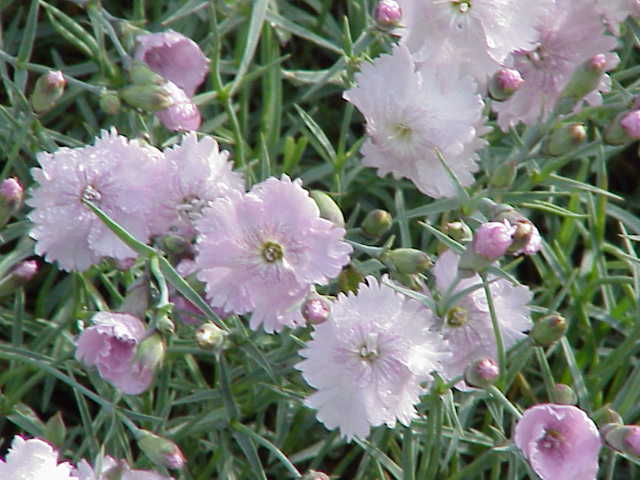
D. gratianopolitanus or Cheddar Pink
This densely tufted perennial herb is now mainly confined to high, inaccessible crevices and ledges on Carboniferous limestone cliffs, though it is also found in tightly-grazed, species-rich limestone turf.
There are some Pinks or Dianthus which are native, but very rare, such as; the Cheddar Pink (Dianthus gratianopolitanus ) of which I obtained seeds through the Hardy Plant Society several years ago.
It only grows native in the British Isles in the Cheddar Gorge near Bristol.

D. armeria or Deptford Pink
Another rare Pink is the Deptford Pink or Dianthus armeria which is now only found at around thirty sites in England and four in Wales. Its largest population is found in Buckfastleigh in Devon and may have been introduced by monks. I grew this delicate plant from seeds collected by an enthusiastic fellow botanist and plant recorder for Northamptonshire.
An annual or short-lived perennial herb of open, disturbed sites, occurring in short grassland in pastures, roadsides, waysides and field margins, and as a casual on waste ground. It usually grows on dry, often mildly basic soils, but has been recorded on fen-peat.
D. gallicus or Jersey Pink
A mat-forming perennial herb that is infrequently grown in gardens and has become naturalised on grassy sand dunes in St Ouen`s Bay, Jersey (Channel Islands), where it was possibly deliberately introduced
Dianthus deltoides or Maiden Pink (neophyte in Ireland)
A perennial herb of dry, usually base-rich, soils overlying chalk and limestone, mica-schist or basalt; sometimes on metal-rich mining spoil or sandy soils and dunes. It can occur in short, closed grassland, but prefers an open sward broken by bare rock or soil.
Sometimes grown as an ornamental rock-garden plant.
